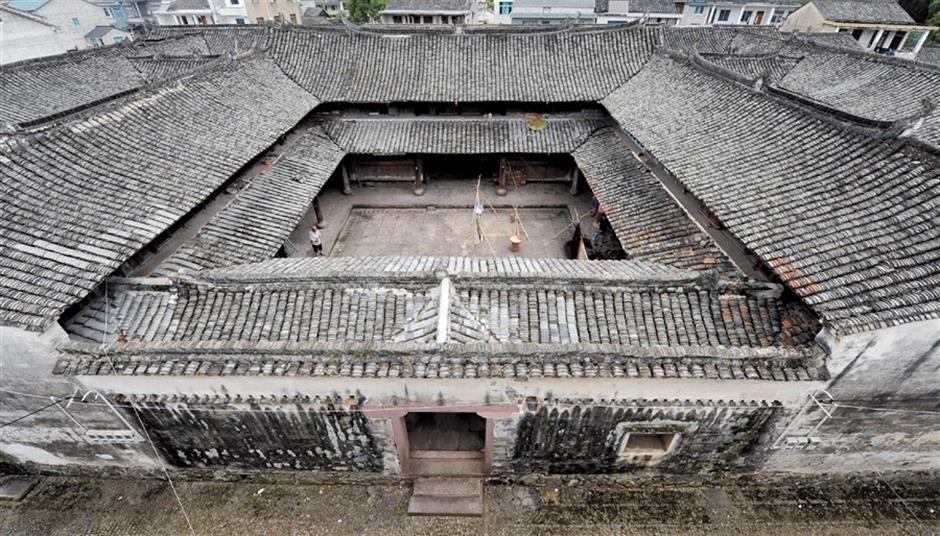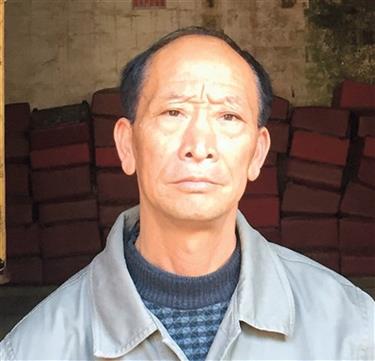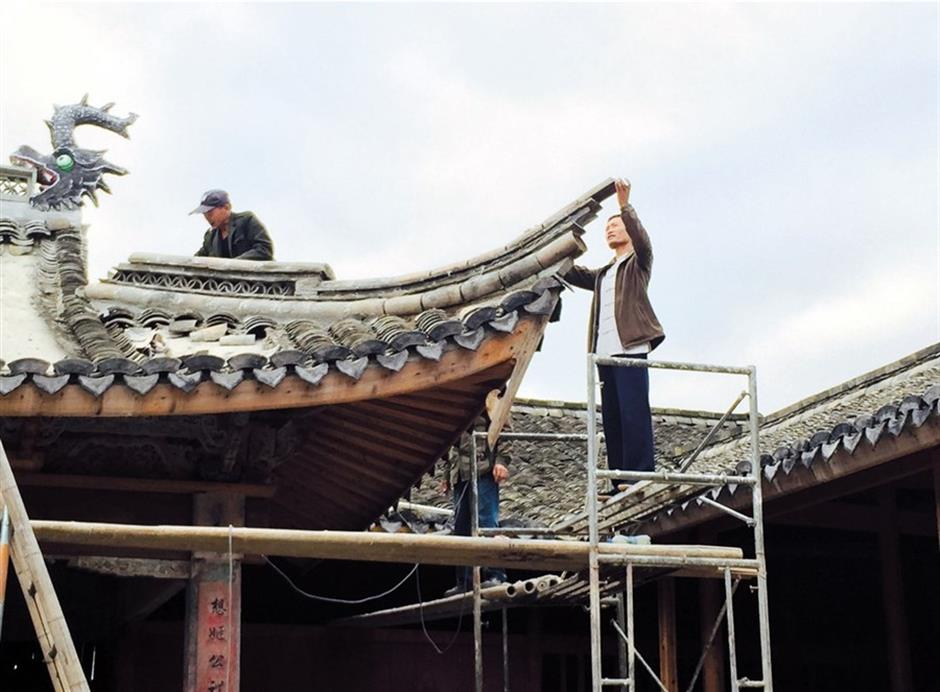Artisans work magic of restoration

Ge Zhaolong's team works on the houses built in Ming and Qing dynasties in Qiantong Town.
A group of uniquely experienced but aging local artisans have been devoting their later years to the tasks of restoring ancient buildings in Ningbo’s Ninghai County.
They live a nomadic life in teams, moving to the location where a building needs rehabilitation. Most of them are aged around 60 and the oldest is over 70. Few of them are younger than 50. Their aim is to preserve ancestral structures using time-honored building crafts and traditional materials.
Zheng Shiqing, aged 64, is the leader of an eminent restoration team of about 30 people in Ninghai.
Zheng and his team completed restoration of the Shuangzhi Temple’s main hall last December in Qingtan Village, Shenzhen Town, Ninghai. The temple was recognized by the State Council in 2006 as a key national cultural relic warranting protection.

Zheng Shiqing
It is an old wood-framed structure dating back 100 years and was designed with a quadrangle courtyard. There is an ancient Chinese stage in the center of the courtyard, open on three sides, elevated by wood pillars in four corners, and covered by a tiled roof with overhanging eaves.
The Buddhas sitting in the temple squarely face the front of the stage. Local villagers used to worship the Buddhas on bended knees and also gathered to watch operas performed on the stage.
Shuangzhi Temple was used as a temporary teaching center by Fenghua High School (in Fenghua District, Ningbo) from 1943 to 1945 during the war of resistance against Japanese aggression.
“The restoration is just finished and it’s raining outside,” Zheng told Shanghai Daily. “We’re checking our work and see no rain leaking through the roof into the main hall. It proves we have successfully restored the roof.”
The main hall of Shuangzhi Temple is a one-story structure with a curved tile roof supported by four pillars.
Dozens of new, round, yellow-colored logs integrated with ancient red lacquered logs can be seen in the roof, all serving as beams for the building.
“The new logs are fir, the same material as the original timber,” said Zheng.
“The size of the logs is also the same, thus applying the so-called restoration technique of using ‘old for old.’ After two years, when the new logs are dried, we will lacquer them with the same red color,” he added.
The roof of the main hall was also completely restored using tiles recovered by Zheng and his team.
“We first lifted the roof with load-bearing materials, making it slightly higher than the original. We then built a platform on which craftsmen could stand to do restoration work. The platform also protected the Buddhas below from the remedial activity,” explained Zheng.
The tiles were meticulously laid to replicate the same curve as the original roof. A cannelure groove was left between each tile line to drain rainwater. The curve line was also designed to enable rainwater to fall slowly from the brims of overhanging eaves rather than cascade in torrents. The curved tile roof is a traditional Chinese style, which was used several hundred years ago and is still frequently seen in old houses in both south and north China.
“Our workers meticulously laid the tiles piece by piece to form the curve, something that can’t be done using modern machines,” said Zheng.
Zheng started learning traditional building crafts at age 18 and eventually worked on larger projects. He became chief engineer of a modern building group and has extensive experience in traditional wood-frame structures and modern building layout design and constructing.
He formed the ancient building restoration team to restore old temples, ancestral halls and stages in Ninghai County. The team has applied a blend of both traditional and modern techniques in applying its many crafts.
“I started restoring ancient buildings in 1991 and have saved many cultural relics, including Baoguo Temple and Tianyige Museum in Ningbo,” Zheng said.
“My proficiency was recognized by many people, including officers from cultural relics protection bureaus. These ancient structures would disappear if we didn’t restore them and then youngsters today would not be able to appreciate them,” he added.
Zheng said the restoration work requires more knowledge and subtle handicrafts than modern building construction and he hopes the results of the group’s work can be sustained through following generations.
“People can easily build a modern house, as long as they can read its layout design, know the length, width and height, and follow the building rules.
“However, ancient buildings don’t have a layout design, and we have to interpret a lot to restore the structure to its original appearance, such as doing on-site measurements and referring to old photos and other recorded data,” he said.
Zheng restored a crossbeam in Shuangzhi Temple’s gatehouse three years ago. The old beam needed to be cut out and it was tricky to install a new one into the original tenon tongue joins of the two support pillars.
The original structure was supported by a traditional mortise-and-tenon joint which used no nails and had been strong enough to survive hundreds of years.
“The project involved changing the beam without moving the two pillars, and a smart idea was required to make it work. Finally, I came up with a solution,” said Zheng.
Without the noise of modern machines, it was a relatively quiet construction scene in the work area of Shuangzhi Temple’s main hall. Zheng and his team lived on site for 40 days and finished a restoration task which was scheduled for 60 days. They did careful checks before leaving. When a corner of the clay carving above a small door was found to have flaked off, a worker climbed up a wooden ladder and gently brushed new clay onto it.
In addition to assuring the quality of restoration, Zheng also managed safety aspects during the restoration process.
“No smoking was allowed on the temple worksite and all bits of wood were removed in a timely manner to prevent fire breaking out,” he said.
Shuangzhi Temple’s main hall was Zheng’s last restoration project in 2016 so that he can head home to celebrate Chinese New Year after the work was completed.

Ge Zhaolong’s team members, comprised of local artisans aged over 50 on average, devote their later years to restoring ancient buildings.
That wasn’t possible for Ge Zhaolong, aged 48, a young but experienced leader of another ancient building restoration team of 30 people in Ninghai. He was busy working on the restoration of old Ming (1368-1644) and Qing (1644-1911) dynasties houses in Qiantong Town.
Ge began learning his building crafts when he was about 20 and started restoring ancient structures with a team in 2000.
“Modern reinforced concrete buildings will survive at most for 70 or 80 years but ancient structures can stand for several hundred years,” Ge said.
“The traditional mortise-and-tenon joint wood-frame buildings offer endless learning opportunities. The surviving guides to ancient techniques embody a craft which can be passed on today during the restoration process,” he said.
He has a passion for ancient buildings and the house he lives in with his family, a wood-frame building of more than 100 years old, was owned by his ancestors.
“I have always loved antique objects and collected old furniture and traditional root carvings to decorate the house,” Ge said.
“In 2000, I collaborated with my friends to start buying ancient local buildings because the villagers wanted to relocate to the improved lifestyle of bright modern houses,” he explained.
“In recent years the government has started to strongly emphasize the protection of ancient structures. So, actually, we had an earlier understanding than the government of the value of these buildings. Business has been good and we had worked on five or six projects last year,” Ge said.
Most of Ge’s team members are aged 50 to 60 years and are organized into three groups to restore ancient buildings in different places.
“Our workers are younger than those in other teams. Nowadays, there are fewer people younger than 50 with a knowledge of these traditional building crafts,” he said.
“Young men today all learn the mechanized production and pipeline operations, such as rounding off timber using modern machines. This is efficient but not the way to succeed in applying traditional crafts,” he added.
“We use axes to shape the timber, resulting in lines more beautiful than those made by machines,” Ge said.
Apart from the carpenters he uses to build wooden frames, three or four carvers in Ge’s team are important contributors to the restoration work.
He added that buildings in south China are usually decorated by carvings, while those in north China are mostly ornamented by colored drawings.
South China has a humid climate and the colors flake off due to moisture. They are not as easy to preserve as those in dry north China.

Ge Zhaolong’s team restores the Wangs’ ancestral hall built during the Qing Dynasty in Ninghai County.
















